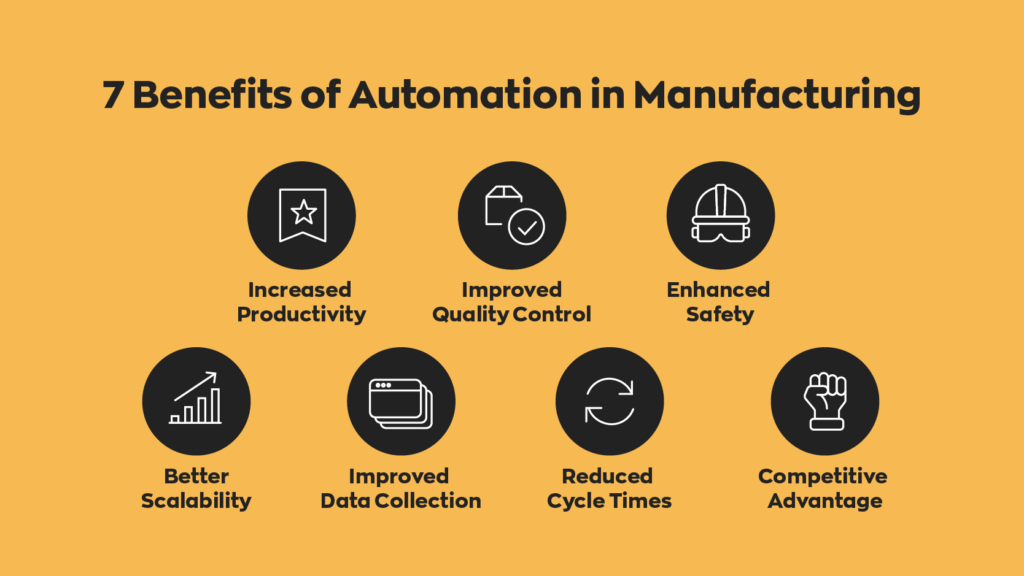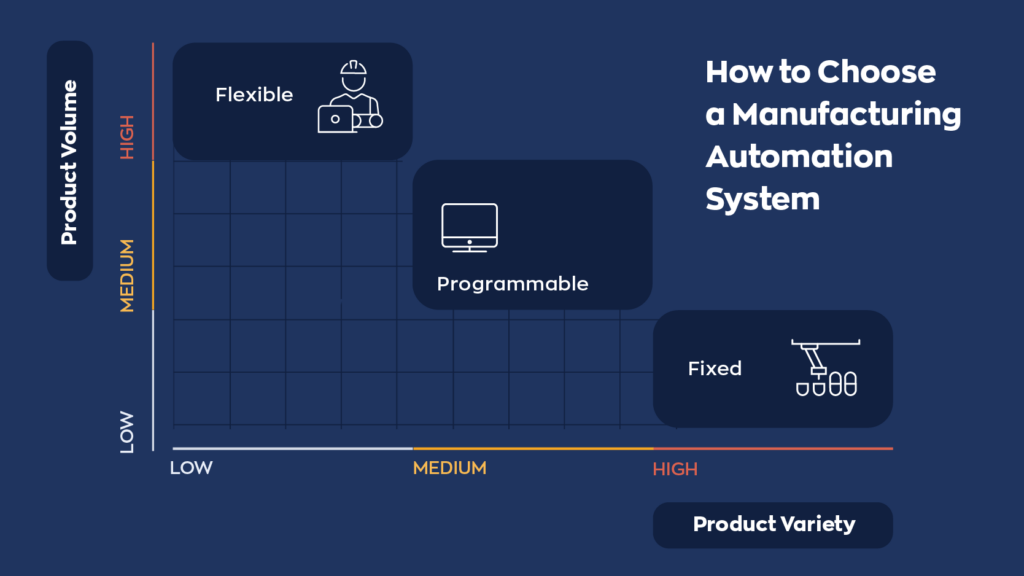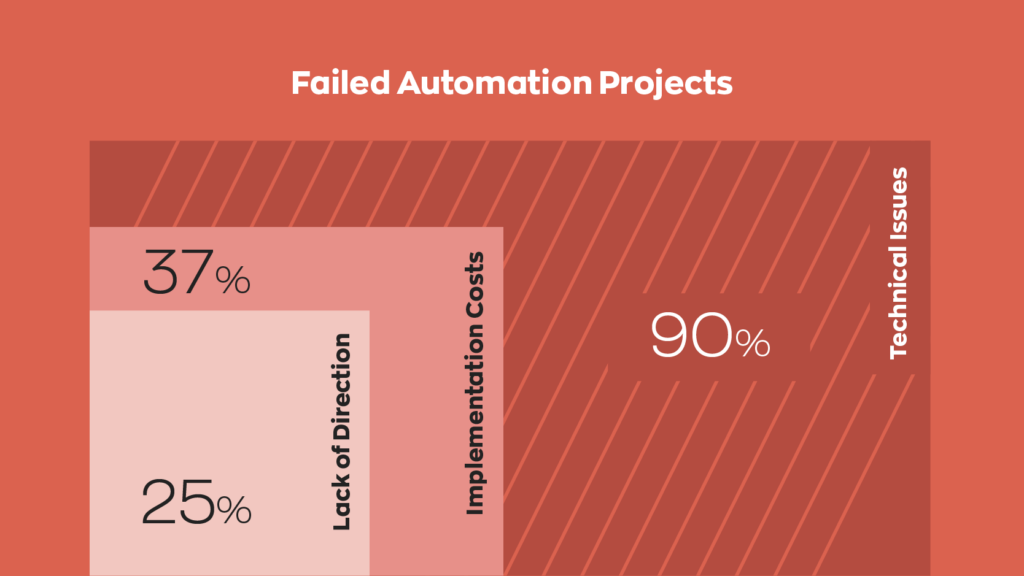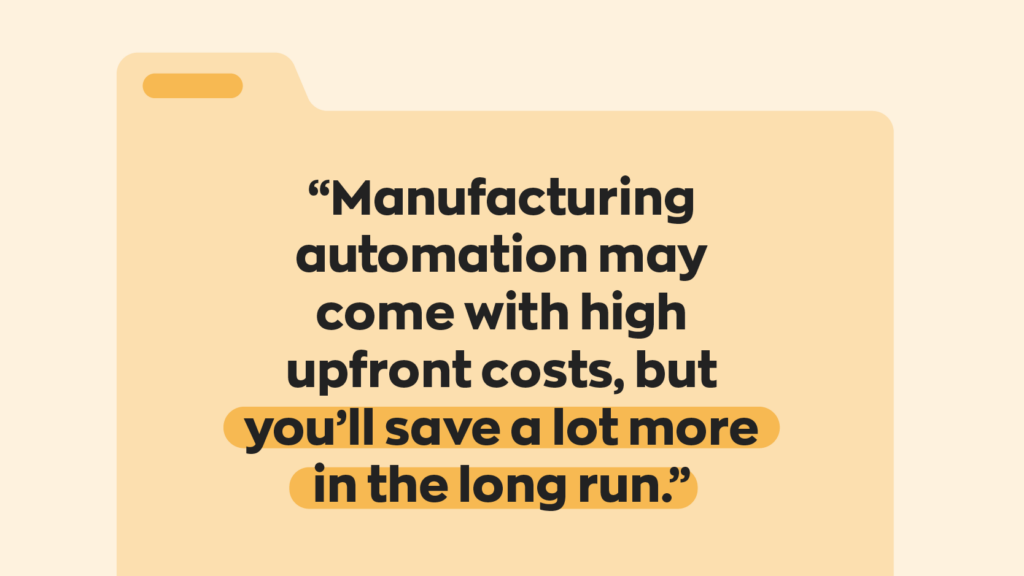The manufacturing process has a lot of moving parts. Different components rapidly move in and out of the warehouse and are subject to price changes. On top of that, manufacturing products in bulk generally brings with it a higher overhead cost. You’ll have to keep up with labor costs, maintenance costs, and so on. These costs increase depending on the level of specialization that the process requires. This is one of the many reasons that more and more manufacturers are turning to manufacturing automation.
That phrase probably summons the image of one of the many sci-fi movies where robots produce everything, putting humans out of work in the process. In reality, automated manufacturing is a bit different.
What is automation in manufacturing?
For the most part, manufacturing automation is exactly what it sounds like. It involves cutting out manual labor to complete as much of the manufacturing process as possible automatically. However, it’s important to note that you can split this manufacturing automation process into two distinctly different categories.

Direct process automation
This is probably what people think of when they hear “robotics” in this context. Instead of relying on human labor, computer-driven automatons perform most of the manufacturing process. This practice can take a few different shapes. Automated manufacturing robots can build products on an assembly line, or a single one can manufacture all on its own.
As a side note, there’s a common fear that giving these jobs to robots will result in widespread unemployment. While the recent influx of AI may seem to lend some credibility to these fears, history suggests otherwise. We’ll get more into that later, but keep that in mind for now.
Peripheral process automation
We already touched on this, but a lot goes into running a manufacturing business. It’s why companies have been turning to manufacturing automation in the first place!
Outside of the manufacturing process itself, manufacturers have to juggle component shipments, customer orders, and keep an eye on inventory levels. They also have to maintain payroll, calculate overhead costs, and many other key business components. It’s a lot to handle.
That’s why automating processes like these is sometimes more important than automating the manufacturing process itself. Bookkeeping errors can be catastrophic, and letting inventory levels dip below acceptable limits can seriously limit revenue. With manufacturing software like inFlow, you can keep track of just about all of this.
We designed our software with manufacturers in mind and equipped them with as much automation as possible. You can check inventory levels in real-time and set reorder points for components, so you’ll never run out of stock. You can also create manufacturing orders from your various components to produce finished products in your system automatically.
These are just a few of the great features we included in our newest manufacturing update to inFlow.
Different automation systems
Of course, every business has different needs, which goes doubly for manufacturers. Accordingly, it should come as no surprise that there are different types of automated manufacturing. Broadly speaking, there are three different manufacturing automation systems that manufacturers use. Here’s a brief description of each.

Fixed automation
Also referred to as hard automation, this is the most rigid form of automation in manufacturing. It’s meant for products that undergo little to no change throughout their lifecycle and are constantly in high demand. Once a fixed automation system is in place, changing the manufacturing process is extremely difficult. Because different machines handle different tasks, making changes results in a cascade effect. Changing one thing renders the other unable to complete its task, and that effect repeats.
Programmable automation
This form of manufacturing automation differs from fixed automation by offering greater flexibility. It allows manufacturers to modify the input and output of the software itself. As a result, one production run can produce anywhere from a dozen units to several thousand. This system is commonly used for products that experience distinct production runs where demand is intermittent.
Flexible automation
As the name suggests, flexible automation is designed to offer flexibility above all else. Unlike the previous systems, flexible automation systems are often directly controlled by human operators in order to control the input and output. As a result, these systems can produce multiple products within a single batch. This system is often used in industries that value products specialized on an individual level.
Aside from being manufacturing automation systems, these three also have one other thing in common: implementing them is expensive. Really expensive. So why are more and more manufacturers turning to automation?

Why do manufacturers use manufacturing automation?
It may sound odd, but sometimes you have to spend money to save money. It’s true that implementing these systems demands an immense upfront payment, but it’s also a one-time payment. Once everything is in place, that’s it. There will still be maintenance and electricity costs, but production speed and accuracy will increase in return. This directly results in greater revenue. It won’t be an immediate return, but the equipment pays for itself over time and eventually leads to profit.
Is manufacturing automation used in every industry?
All manufacturers of all shapes and sizes can benefit from manufacturing software. And this type of automation is undoubtedly the least expensive to implement. However, when it comes to automating the manufacturing process itself, some companies may be better off sticking with manual methods. As useful as automation is, and even though we covered an automation system called “flexible automation,” every automation system has some level of rigidity.
Flexible automation is fine when the product shares a common foundation, but some industries regularly demand unique products. In cases like these, attention to detail is more important than production speed.
If we’re also going over every industry, there’s some that simply place no value on automation. For example, despite what creators of such programs claim, no one is quite ready to pay for AI art.
Will automation cause unemployment?
Yes. And I, for one, welcome our new robot overlo–
No. All joking aside, this is a widely perpetuated myth that’s been catapulted to new heights by the recent AI craze. Something we repeatedly mentioned above are maintenance costs. Automation inherently requires robotics with the capacity to propel themselves. In other words, they require moving parts, which means they’re subject to wear and tear. And a lot of it.

It seems a bit antithetical to the situation at hand, but the need for maintenance workers creates more work opportunities. And this is often skilled labor that brings with it the requirement for higher pay. And while it might not seem like it, maintenance isn’t necessarily something that requires a high-end robotics degree. Designing such systems might, but hands-on work requires a different skill set altogether. For example, we trust electricians to work on our homes, and most of them go through trade school.
There’s also a lot of truth that humanity will always need specialized products. Niche industries are also some of the most lucrative, and usually, their needs demand workers with an eye for detail. If that’s not enough, data also suggests that manufacturing automation creates jobs instead of reducing them.






Great insights on the role of automation in manufacturing!
Hey Devanshu,
We’re glad you enjoyed it! Thanks for reading.
Cheers,
Jared